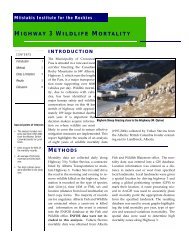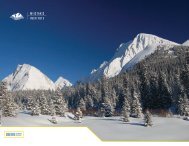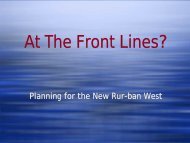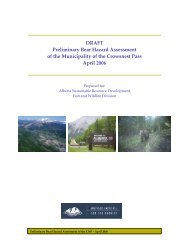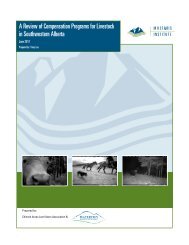A GIS based approach to restoring connectivity across Banff's Trans ...
A GIS based approach to restoring connectivity across Banff's Trans ...
A GIS based approach to restoring connectivity across Banff's Trans ...
You also want an ePaper? Increase the reach of your titles
YUMPU automatically turns print PDFs into web optimized ePapers that Google loves.
The Banff-Bow Valley provides much of <strong>Banff's</strong> best montane and subalpine wildlife habitat. Pho<strong>to</strong> by<br />
Stephan Legault.<br />
integrity [be] the first priority of all aspects of<br />
national parks management” (Parks Canada 2000).<br />
Banff National Park encompasses approximately<br />
6640 km 2 of rugged mountainous terrain, steep<br />
valleys, and narrow flat valley bot<strong>to</strong>ms located 110<br />
kilometres west of Calgary, Alberta. Vegetation can<br />
be classified in<strong>to</strong> three broad ecoregions: montane<br />
(1300-1600 metres), subalpine (1600-2300 metres)<br />
and alpine (above 2300 metres). The montane is<br />
dominated by lodgepole pine, Douglas fir, white<br />
spruce, aspen and grasslands, while subalpine areas<br />
contain mature lodgepole pine, Engelmann spruce,<br />
subalpine fir and subalpine larch. Tundra vegetation<br />
dominates the alpine ecoregion, including low<br />
shrubs, herbs, mosses and lichens (Alexander 2001).<br />
Since its designation in 1885, Banff National Park<br />
and the surrounding area have become increasingly<br />
developed. Outside the boundaries of the park, on<br />
Alberta Crown lands <strong>to</strong> the east and south, a variety<br />
of commercial and recreational land-uses proliferate,<br />
including hunting, ranching, oil & gas and forestry<br />
development, both mo<strong>to</strong>rized and non-mo<strong>to</strong>rized<br />
recreation, and various <strong>to</strong>urism activities. Canmore, a<br />
<strong>to</strong>wn of 10,000 residents that will peak at 30,000 in<br />
10 <strong>to</strong> 20 years, sits just outside the park’s east gate.<br />
Banff is now Canada’s most heavily visited national<br />
park (Clevenger et al. 2002). More than 4.5 million<br />
annual visi<strong>to</strong>rs make use of the <strong>to</strong>wns of Banff and Lake<br />
Louise and other infrastructure that has been designed<br />
for their use and enjoyment: hiking, biking and<br />
equestrian trails; campgrounds in both the front- and<br />
backcountry; day use areas; and downhill skiing and<br />
PAGE 12<br />
IMPROVING CONNECTIVITY ACROSS BANFF’S TRANS-CANADA HIGHWAY



